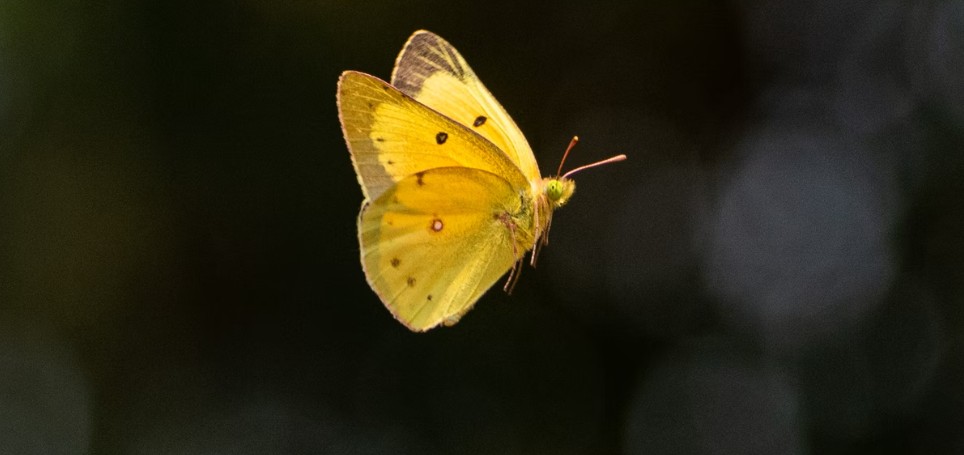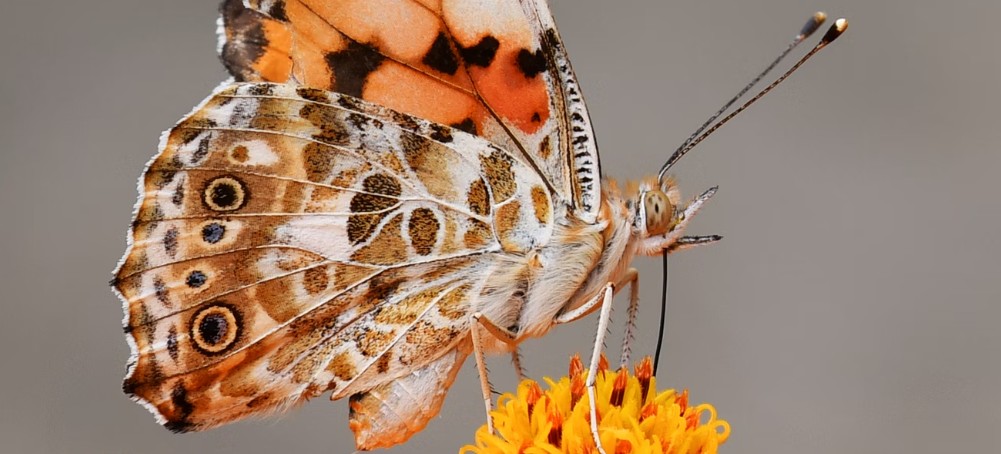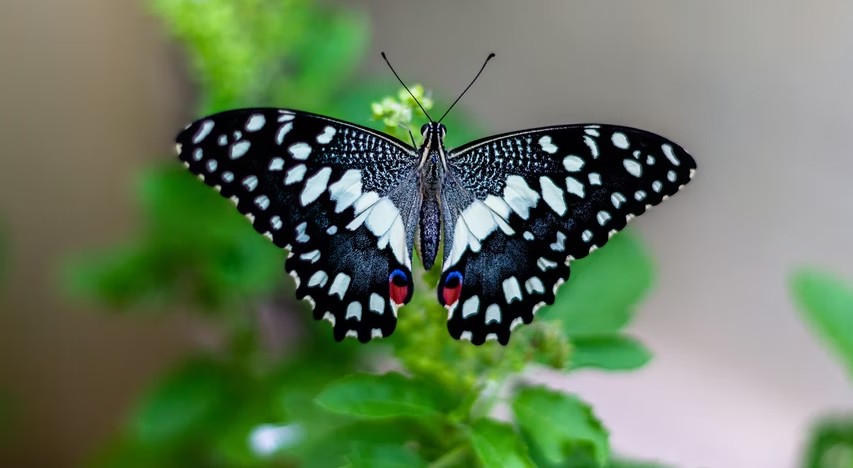
Can Butterflies See Their Wings?
The answer is yes and no. Like most insects, butterflies have compound eyes. These are made up of many lenses, each with its own job. One lens detects movement, another detects color and another detects light levels. This is how they see the world as a series of outlines and shapes, rather than as a collection of colors and textures.
Butterflies can also see their wings, but only vaguely. They can see them in motion and will use this motion to judge wind speed or direction when they take flight. But they can’t see the details of their wings or other objects in their environment because their vision is so narrow compared to what we experience every day on Earth.
Interesting facts about butterfly eyes
Butterflies are among the most beautiful creatures on Earth. They’re also some of the most fragile and delicate, which is why they need to be extra careful when they’re flying around in the air. Butterflies have excellent vision and can see everything from movement to ultraviolet light. Let’s take a look at some of the most fascinating aspects of butterfly eyes!
Butterflies have about 6,000 lenses in each eye.
You may be surprised to learn that butterflies have about 6,000 lenses in their eyes. Each lens is made of transparent tissue that contains protein molecules. These proteins are arranged to form a lens, which focuses light on the photoreceptor cells at the back of a butterfly’s eye.
Butterfly eyes are very sensitive to movement.

>Butterfly eyes are very sensitive to movement. These butterflies are able to fly and hover in place, but they can also quickly identify and avoid predators by moving their wings in a way that creates disturbances in the air around them. This strategy allows them to see what’s going on around them from afar.
Butterflies can see ultraviolet light.
Butterflies are able to see ultraviolet (UV) light, which is also known as black light. In fact, butterflies can see more of the UV spectrum than humans and most other animals. While we can only see between 380nm and 700nm of UV light, butterflies may be able to detect wavelengths from 320 nm (ultraviolet C) up past 400 nm (ultraviolet B).
They do this by using photoreceptors in their eyes that contain rhodopsin proteins, which absorb photons and convert them into signals that travel along nerve cells called optic nerves. In humans, these receptors are tuned to respond to wavelengths outside of visible light — an evolutionary adaptation that helps us avoid harmful stimuli like flowers with dark colors or harmful chemicals in the environment around us!
A butterfly’s eyes can’t focus.
The eyes of butterflies are designed to see in all directions at once. Butterfly eyes are not focused on one thing, but rather they can see in all directions at once. Their eyes have many lenses and retinas, but they only have one optic nerve and brain that controls vision. In addition to their complex visual system, butterflies also possess very sensitive antennae that help them find food like flowers and fruit.
Interesting facts about butterfly wings
Butterfly wings are beautiful, and it’s no surprise that they attract our attention. But did you know that these beautiful wings actually have some interesting functions? Let’s take a look at several facts about butterfly wings – from their unique design to what makes them so colorful!
Butterfly wings have tiny scales on them that overlap each other
The structure of the butterfly’s wings is called the “microscopic” level. The microstructure of a butterfly wing consists of more than 30,000 tiny overlapping scales, called papillae. These are arranged in rows and columns with a specific pattern and color. Each row has one color per row: red at the top, then orange and yellow; blue at the bottom.
Their wings are made of chitin

Chitin is a tough polymer that provides the structural support for butterfly wings. In fact, chitin is the same material found in crab shells and shrimp shells. It’s also in the exoskeleton of insects.
Chitin is made up of chains of glucose molecules and has a molecular weight similar to cellulose, which makes up plants like trees and grasses.
Butterfly wings are transparent when they first hatch.
Butterfly wings are clear when they first hatch. They don’t have the pigments and coloration that you see in adult butterflies’ wings; it’s only after they’ve eaten their first meal that they gain their pretty colors.
Many butterfly species mimic the coloration and patterns on poisonous butterflies
Butterflies have been around for millions of years and are one of the most diverse groups of insects on the planet. They have evolved many forms of defense mechanisms, including brightly colored wings that mimic those of poisonous butterflies. This is known as aposematism, a form of warning coloration: insects like monarchs and swallowtails use this strategy to tell predators that they taste bad or are toxic with bright colors in an attempt to deter them from attacking.
Some butterflies mimic other species entirely; these are known as Batesian mimics because they are harmless but look similar enough to another species or group that predators will avoid them (and eat their models instead).
The largest butterfly has a wingspan of almost 12 inches.
The largest butterfly on Earth is the Queen Alexandra’s birdwing. Its wingspan can reach over 12 inches, making its body look like it’s just a tiny part of those wings. This butterfly is found in Papua New Guinea, where it feeds on rotting fruit and nectar from trees.
The smallest butterflies have wingspans as small as 1/2 inch, but they’re mostly found in South America and Australia.
Butterfly wings come in a variety of shapes and sizes
Butterfly wings come in a variety of shapes and sizes, depending on the species. The smallest butterfly species have wingspans less than an inch wide, while the largest has a wingspan of almost 12 inches. There are also many different types of coloration among butterfly wings, including yellow and orange, blue and brown, black and white—and even striped!
All butterflies have four wings that are covered in scales called “chitin.” These scales are transparent when they first hatch but become darker as the insect ages. Some butterflies also have patterns on their wings (like Monarch butterflies), which help them blend into their environments so predators can’t see them easily when they’re sleeping or resting after mating flight (a type of flight where males try to find mates). If you look closely at these patterns you’ll notice they’re made up of tiny dots or even lines across each wing surface that make up one big design together.
Butterfly wings have a range of colors and patterns.
And if you’ve ever wondered why butterflies have such beautiful wings, the answer is simple: they’re a highly visible way for these creatures to find their mates.
Butterfly wings can be found in an array of colors and patterns. Some species have wings that are predominantly blue, while others sport yellow or black stripes. In some cases, the butterflies’ coloration is covered by veiny lines and spots—which help them blend into certain environments and ward off predators (like birds).
Butterflies don’t only have vibrant hues—they also come in a variety of shapes and sizes! Though most species tend to follow a general shape for their wingspan (more on this later), there are plenty of exceptions: some butterfly species have large eyespots; others sport spiky edges; still others feature very thin membranes between each wing segment…the list goes on!
You probably know that the wings of a butterfly are different from those of other insects. But do you know why? They’re not like the wings of a bird, which are used to fly. Instead, they exist because butterflies need them to fly around and be visible to potential mates as they look for food.
Butterfly wings aren’t like bird feathers or bat membranes either: they don’t attach directly to the body and aren’t used for protection like these other animals’ appendages do. Instead butterfly wings are made up of tiny scales attached to veins made mostly out of chitin (the same material that makes up shellfish exoskeletons). These veins support the lightweight tissue underneath so it can flap back and forth when butterflies move quickly through air currents like pollination agents or predators might use while searching for prey nearby—or perhaps even during mating rituals!
Butterfly wings are fragile and can break easily.

One might assume that the wings of a butterfly are sturdy enough to protect it from harm, but in fact they are extremely fragile and can break easily. Butterflies use their wings for flight, which requires them to be strong enough for lift and maneuverability. So how do butterflies accomplish such a feat?
The answer lies in chitin, the substance from which these delicate wings are made. Chitin is one of nature’s strongest fibers, as well as being resistant to bacteria and fungi. It’s also waterproof!
The transparency of newly hatched butterfly wings is another factor worth mentioning: when butterflies hatch from their cocoons, they’re usually quite pale; this helps them avoid predators until their coloring develops further into adulthood (and makes them harder for humans like us!)
Can butterflies see their wing color?
Butterflies can see their wing color, but they can’t see it with the same clarity that humans do.
Butterfly wings are covered with tiny scales, called “pigment cells.” These pigment cells contain pigments that give butterflies their beautiful colors. When light hits these pigment cells, it is reflected back at the viewer’s eye and that creates the butterfly’s color pattern.
Butterfly eyes have three types of photoreceptors — one for detecting red light, one for green light and one for blue light.
A butterfly’s eyes have many more rods than cones, so they are not able to see in as much detail as humans can. In fact, butterflies have about half as many cones as humans do! But because each cone has a wide field of view, butterflies can see wide swaths of color at once rather than having to look at each individual dot of color like humans do when we look at something with our naked eyes.
Can butterflies see how pretty they are?
Yes, butterflies can see how pretty they are.
Butterflies have compound eyes, which is a group of many small eyes working as one. The compound eye has many tiny lenses called ommatidia that work together to form an image. This is why butterflies seem to be able to see you when you are right next to them.
To see better, butterflies have a second set of eyes called “eyelashes.” These eyelashes are called ocelli and they help the butterfly determine where light comes from so it can fly away from it.
The color of butterfly wings is also important for survival. It is used by birds and other animals as a way for them to find food or avoid danger. This is why butterflies have such bright colors on their wings. The bright colors draw attention from predators so the butterfly can flee before being eaten!
Why can’t you touch a butterfly’s wings?
The reason you can’t touch a butterfly’s wings is because butterflies are very fragile. The wings of butterflies are covered in tiny scales that help the butterfly get air through them. If you touch or even brush against them, it might break those scales and ruin the butterfly’s ability to fly.
Butterflies also have very delicate digestive systems. If you touch them, you might accidentally hurt them or make them sick from your dirty hands or fingernails!
Butterflies are also very sensitive to temperature changes, so if you hold a butterfly for too long, it might get too cold or too hot and die!
Butterflies have very short lifespans — only a few months — so they need to spend most of their time flying around looking for food and mates instead of resting on someone’s hand while they’re being admired!
Can butterflies feel pain?
Butterflies are invertebrates, so they don’t have a spine and don’t feel pain in the same way that humans do. But that doesn’t mean that butterflies don’t react to things like heat or cold in similar ways as humans.
The answer lies in how we define “pain.” Butterflies can sense when their bodies are being harmed, but their nervous system doesn’t interpret these sensations as pain. For example, if you step on a caterpillar or crush a butterfly’s wing, it will react with an involuntary jerking motion. This reflex is called nociception and is present in most animals. Many people believe that nociception is evidence of pain, but it isn’t necessarily so — it just means that certain body parts are responding to harmful stimuli by sending signals through the nervous system.
Conclusion
There are many unique qualities about butterflies that make them stand out from all other insects. I wish to shed light on one of the many aspects about butterflies that most people don’t know about–their ability to see their wings. While it’s true that butterflies can see their wings, it isn’t for the reason you may think.